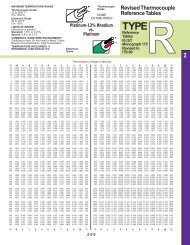Using Thermocouples
Using Thermocouples
Using Thermocouples
Create successful ePaper yourself
Turn your PDF publications into a flip-book with our unique Google optimized e-Paper software.
single most important answer to this question is that the<br />
thermistor, the RTD, and the integrated circuit<br />
transducer are only useful over a certain temperature<br />
range. <strong>Thermocouples</strong>, on the other hand, can be used<br />
over a range of temperatures, and optimized for various<br />
atmospheres. They are much more rugged than<br />
thermistors, as evidenced by the fact that<br />
thermocouples are often welded to a metal part or<br />
clamped under a screw. They can be manufactured on<br />
the spot, either by soldering or welding. In short,<br />
thermocouples are the most versatile temperature<br />
transducers available and, since the measurement<br />
system performs the entire task of reference<br />
compensation and software voltage to-temperature<br />
conversion, using a thermocouple becomes as easy as<br />
connecting a pair of wires.<br />
Thermocouple measurement becomes especially<br />
convenient when we are required to monitor a large<br />
number of data points. This is accomplished by using<br />
the isothermal reference junction for more than one<br />
thermocouple element (see Figure 13).<br />
A reed relay scanner connects the voltmeter to the<br />
various thermocouples in sequence. All of the voltmeter<br />
and scanner wires are copper, independent of the type<br />
of thermocouple chosen. In fact, as long as we know<br />
what each thermocouple is, we can mix thermocouple<br />
types on the same isothermal junction block (often<br />
called a zone box) and make the appropriate<br />
modifications in software. The junction block<br />
temperature sensor R T is located at the center of the<br />
block to minimize errors due to thermal gradients.<br />
Software compensation is the most versatile<br />
technique we have for measuring thermocouples. Many<br />
thermocouples are connected on the same block,<br />
copper leads are used throughout the scanner, and the<br />
technique is independent of the types of thermocouples<br />
chosen. In addition, when using a data acquisition<br />
system with a built-in zone box, we simply connect the<br />
thermocouple as we would a pair of test leads. All of the<br />
conversions are performed by the computer. The one<br />
disadvantage is that the computer requires a small<br />
amount of additional time to calculate the reference<br />
junction temperature. For maximum speed we can use<br />
hardware compensation.<br />
+<br />
–<br />
Voltmeter<br />
HI<br />
LO<br />
All Copper Wires<br />
ZONE BOX SWITCHING<br />
Figure 13<br />
Hardware Compensation<br />
Rather than measuring the temperature of the<br />
reference junction and computing its equivalent voltage<br />
as we did with software compensation, we could insert<br />
a battery to cancel the offset voltage of the reference<br />
junction. The combination of this hardware<br />
compensation voltage and the reference junction<br />
voltage is equal to that of a 0ºC junction.<br />
The compensation voltage, e, is a function of the<br />
temperature sensing resistor, R T . The voltage V is now<br />
referenced to 0ºC, and may be read directly and<br />
converted to temperature by using the NBS tables.<br />
Another name for this circuit is the electronic ice point<br />
reference. 2 These circuits are commercially available for<br />
use with any voltmeter and with a wide variety of<br />
thermocouples. The major drawback is that a unique ice<br />
point reference circuit is usually needed for each<br />
individual thermocouple type.<br />
Figure 15 shows a practical ice point reference circuit<br />
that can be used in conjunction with a reed relay<br />
scanner to compensate an entire block of thermocouple<br />
inputs. All the thermocouples in the block must be of the<br />
same type, but each block of inputs can accommodate<br />
a different thermocouple type by simply changing gain<br />
resistors.<br />
Fe<br />
C<br />
R T<br />
Pt<br />
Pt - 10% Rh<br />
Isothermal Block<br />
(Zone Box)<br />
Z<br />
+<br />
–<br />
v<br />
Cu<br />
Cu<br />
Fe<br />
Fe<br />
C<br />
Fe<br />
– +<br />
T<br />
+<br />
Cu<br />
Fe<br />
T +<br />
v<br />
C<br />
= =<br />
Cu<br />
–<br />
Fe<br />
–<br />
Cu<br />
+<br />
Cu<br />
R T<br />
Fe<br />
C<br />
Cu<br />
Cu<br />
-<br />
T<br />
e<br />
2<br />
Refer to Bibliography 6.<br />
Z-24<br />
0°C<br />
HARDWARE COMPENSATION CIRCUIT<br />
Figure 14














